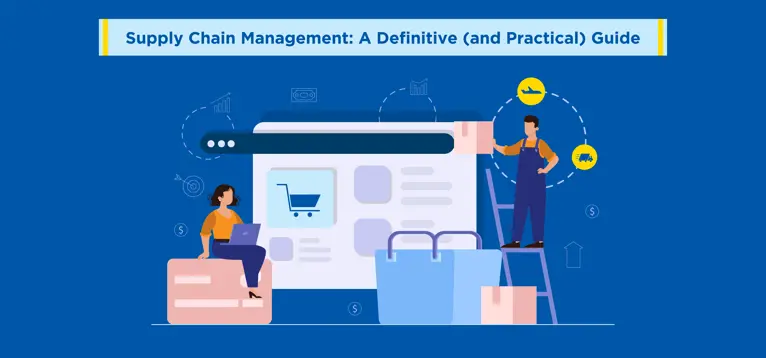Efficient Supply Chain Management (SCM) is crucial for a company’s success. Companies depend on supply chain management to fulfil product demand and maintain the flow of products. It has a direct impact on a company’s financial planning, profit margins, marketing activities and customer service.
Hence, it is necessary for all businesses to understand the fundamentals of supply chain management. This article covers what is supply chain management and how it works. You will also learn different models of SCM systems.
Let’s dive in.
Supply Chain Management Definition
A supply chain is the journey of a product from raw materials to the customer. It includes a set of activities that converts raw materials into products and then delivers them to a business’s customers. Supply chain management is the planning, supervising, and execution of this system.
The SCM process includes procurement, manufacturing, storage, logistics, distribution, and transport. It requires several professionals and businesses to commit to one process. With the supply chain management process, a company can produce products and deliver them to its customers.
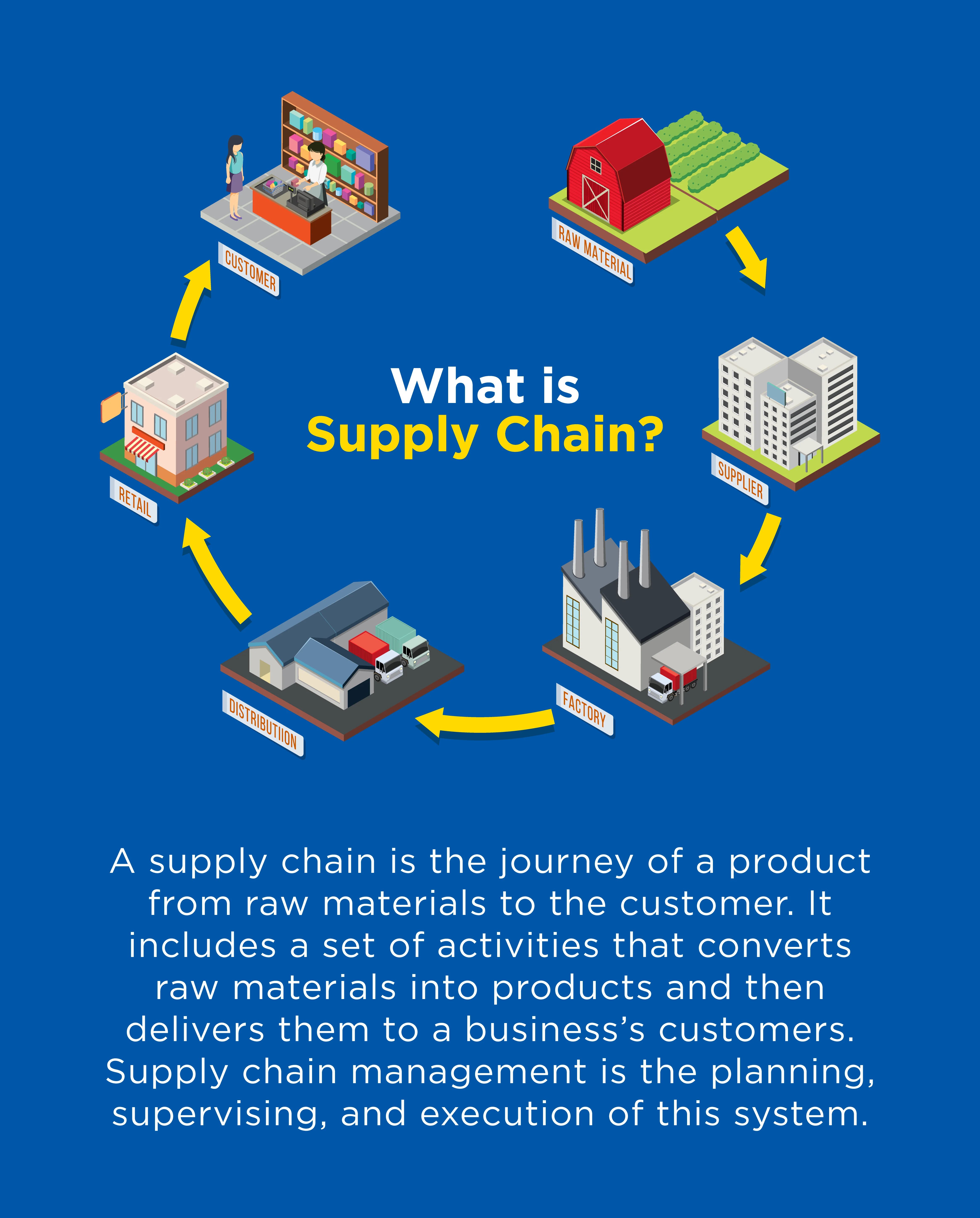
But, supply chain management can vary for different types of companies. For instance, SCM for a reseller begins with sourcing finished products from a supplier. But, for a manufacturing company, it begins with sourcing raw materials.
Despite differences in components, all supply chains follow the same process. This process is divided into five stages.
5 Stages of Supply Chain Management
The five stages of SCM help you develop a process to manufacture products and deliver them to the customers. These stages also serve as a step-by-step guide for companies to define their supply chain management strategy.
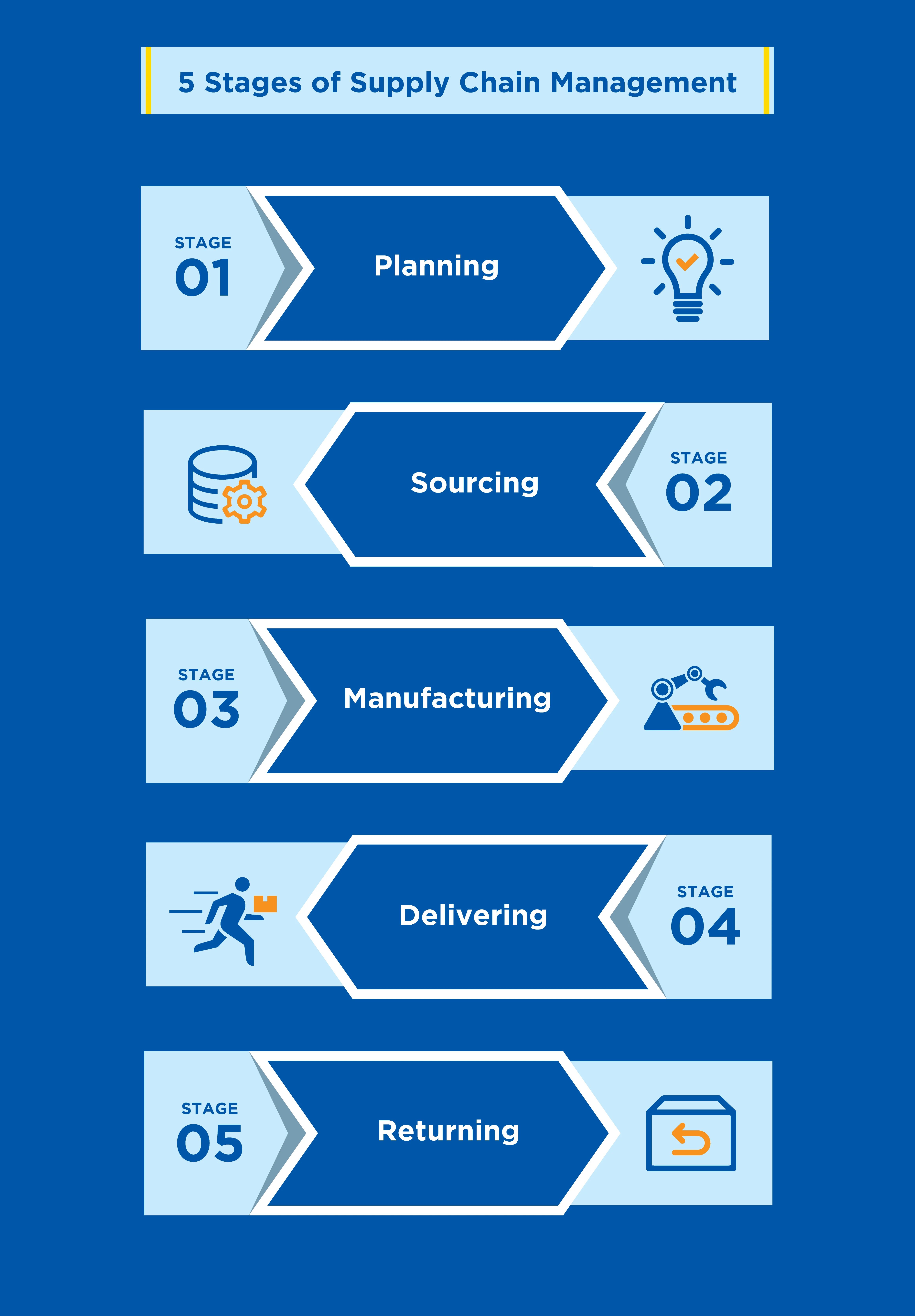
Stage 1: Planning
Supply chain planning begins with estimations regarding demand and supply. This means that you need to understand how many products you can sell in a given time. Then you have to identify the requirements to create that volume of products. These requirements include time, cost, resources, and capacity.
Alongside this, you also need to consider the interconnected nature of your resources and the long-term implications of using them in a certain way. For instance, you can use the manufacturing unit at maximum capacity to develop more products. But this will have an adverse effect on the equipment’s health and longevity.
At this stage, you have to develop a supply chain strategy based on product demand forecasting. After that, you will have to estimate whether each aspect of SCM can meet the requirements to fulfil that demand.
Let us understand this better with a supply chain example. Say you want to sell 50,000 products in a year. First, you will need to ensure that the suppliers can facilitate the manufacturer to produce 50,000 products. Then you need to consider the manufacturer’s capacity to produce those products within a given time.
You will also need to determine the time limit for manufacturing based on storage capacity and supply chain logistics. For instance, if you have the capacity to store only 10,000 products at a time, you will need to space out the manufacturing based on this limit. At the same time, you need to ensure that you can transport that volume of products.
And finally, you need to consider the cost of operations to execute the ideal supply chain management strategy. Then you make adjustments in the strategy to suit the budget, but without compromising on time.
Supply chain operations have a lot of components and variables. That is why the planning stage is the most important among supply chain processes. It determines the cost of operations, resource requirements, profit margins, cash flow cycles, and more.
The planning stage will give you a complete vision of the entire supply chain system. It will also help you identify opportunities to reduce costs and improve efficiency.
Stage 2: Sourcing
At this stage, you need to look for external supply chain management solutions for different components. The extent of sourcing depends on your business strategy and in-house resources. An analysis of your resources will help you identify gaps in the supply chain.
Then you will have to find the right vendors to complete your supply chain processes. Below are the most important components to consider at this stage.
- Supplier for Raw Materials
- Manufacturer to Produce Goods
- Logistics Solutions
- Storage Facility
- Product Distributors
- Order Fulfilment Solutions
Here you will only need to consider the supply chain operations that you need to acquire or outsource. You can also source vendors to increase the capacity of your supply chain. Such vendors are useful if you come across unexpectedly high demands.
Before you begin sourcing, you need to define your requirements for each component. This will help you define the criteria for your ideal vendor. For instance, if you are a manufacturer with a capacity to produce 20,000 products. You will also need to source a logistics partner to store and transport that volume.
The criteria for each component may be different. But, there are a few characteristics that you should seek in each vendor. These include output quality, market reputation, timely delivery, flexibility, maximum output capacity, and fair pricing.
Besides, you also need to procure resources such as labour and equipment to run your in-house supply chain operations. The primary purpose of the sourcing stage is to fill the gaps in supply chain management.
Stage 3: Manufacturing
At this stage of SCM, you convert raw materials into finished goods. This stage determines the quality of the product and supply volume. It also has a significant impact on other aspects of supply chain management. These include the cost of operations, logistics, marketing planning, profit margins, and so on.
Manufacturing in supply chain operations can mean different things for different businesses. It refers to creating products from raw materials for a retail company. While for an eCommerce reseller, it means re-branding sourced products.
Despite different interpretations, the purpose of this stage is the same. It is intended to create the final version of a product. This is the product version that your customers will receive.
The manufacturing stage is divided into several tasks. These include processing, assembly, inspection, quality test, and packaging. To complete these tasks, a manufacturing unit uses several resources. These include raw materials, labour, equipment, machines, power, and so on.
During this stage of supply chain management, you need to be mindful of the proper utilisation of resources. You will find opportunities to reduce waste, optimise processes, upgrade equipment, train employees and so on. You can develop an efficient manufacturing process if you identify and capitalise on such opportunities.
Stage 4: Delivering
The Delivery stage is part of the supply chain logistics. It includes the distribution, transport, and storage of finished products after manufacturing. Depending on the supply chain strategy, this stage may involve several cycles of storage and transport.
The first cycle requires the transport of products from the manufacturer to the distribution or fulfilment centre. Here the finished products are catalogued and stored. At this stage, the products become part of the inventory management system.
The second cycle of delivery involves order fulfilment. Here the product is packed for shipping. Then you again turn to logistics to deliver the product to the customer. The delivery stage of the supply chain management process is complete when the customer receives the product.
The number of delivery cycles is different for different businesses. For instance, for a retail outlet, the second cycle of delivery includes the transport of products to the retail outlet. Similarly, some businesses may have multiple delivery cycles in their supply chain operations. For instance, some products go through distributors, wholesalers, and retailers before reaching the customers.
Stage 5: Returning
This stage is also known as reverse logistics. It is a process through which a customer can return the purchased product back to the company. You will need to develop an easy supply chain process to facilitate cancellations and returns. It is a crucial aspect of supply chain management as the ease of returns has a direct influence on purchase decisions.

At this stage, your logistics partner picks up the product from the customer and delivers it to the company’s outlet or fulfilment centre. Here you check the product and verify the validity of the customer’s complaint. Then you process refunds or compensation as per your company’s policy.
At this stage, you also need to identify common reasons for product returns. Then you can address those reasons and change your supply chain strategy accordingly. For instance, if the biggest reason is defective products. Then you need to make changes in your manufacturing process to improve product quality.
Resolving the underlying causes behind product returns can benefit several aspects of your business. Firstly, you will see a drop in the rate of product returns. Secondly, you have to spend fewer resources on supply chain logistics to facilitate returns. Thirdly, you get more profits because you have to pay fewer refunds. And finally, you can improve customer satisfaction and brand reputation.
6 Supply Chain Management Models
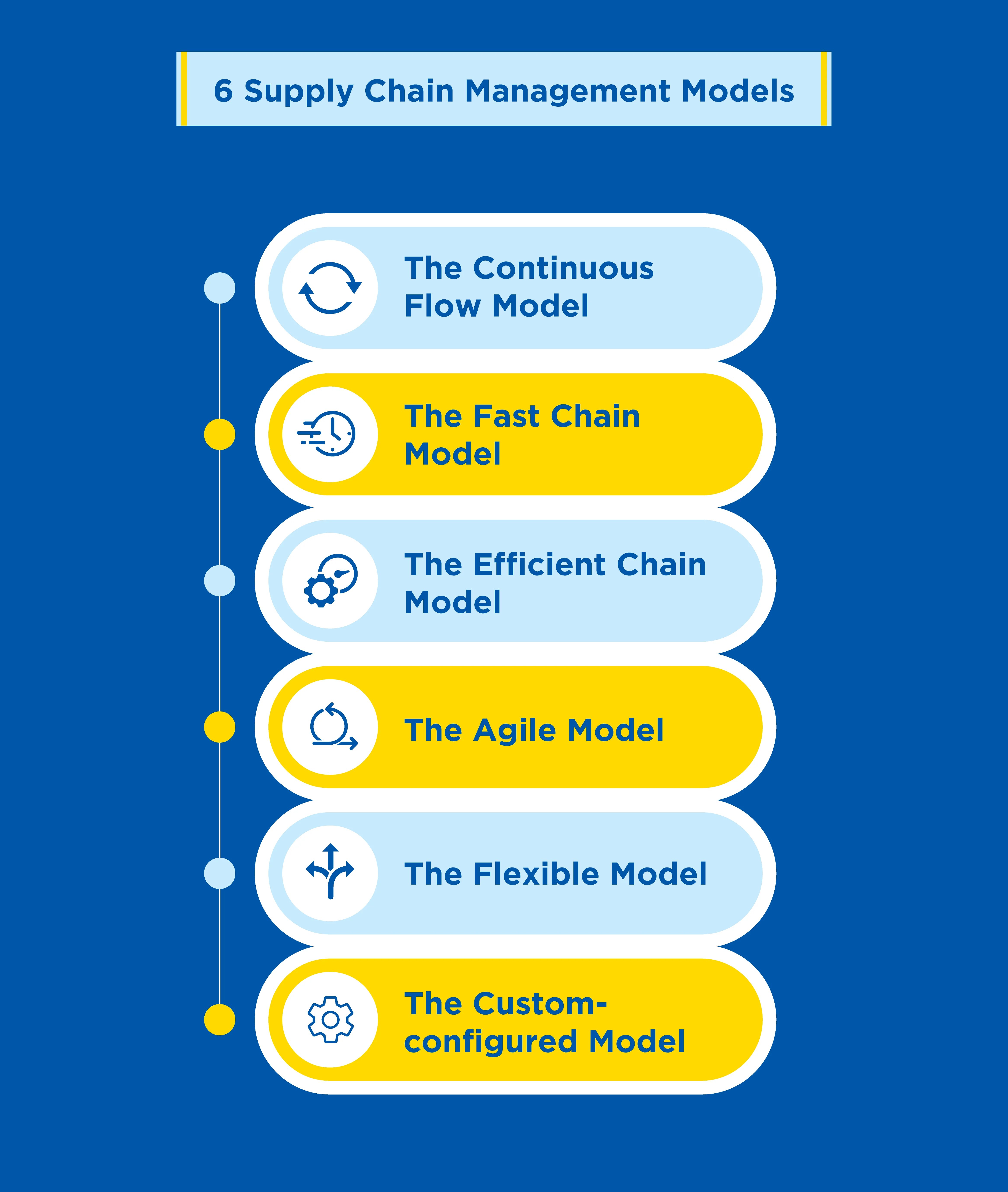
Each business needs to employ different supply chain management strategies to achieve its business goals. Different companies also have different business models, resources, assets, budgets, and limitations. Hence, you need to understand all the models of SCM.
Then you can choose the model that best suits your business requirements. Understanding different models is also crucial for supply chain planning. This is because your chosen SCM model will determine all other components. Below are the six supply chain models you need to know before implementing any of them.
The Continuous Flow Model
As the name suggests, this supply chain strategy is built around a continuous flow of products from the manufacturer to the customer. This model utilises the cyclical aspect of supply chain management to create a continuous process. Here supply chain operations are designed to consistently feed the manufacturer with raw materials and distribution centre with products.
It is a system designed to operate like clockwork. This model is ideal for companies that produce the same products over and over again. Such companies usually have a steady and predictable demand.
However, this model does not have much flexibility for variation in product demand. It is also quite resource-intensive and requires continuous maintenance. This model is not suitable for businesses that frequently change or upgrade their products.
The Fast Chain Model
This model is suitable for companies that create products with a short life span. Such products either capitalise on a trend or are made in response to a trend. You need a flexible supply chain strategy to adopt this model.
This model is designed in such a way that it can easily pivot the supply chain operations. It is ideal for companies that wish to capitalise on the first mover’s advantage in a market. Retail fashion companies are the best supply chain examples of this model.
In the fast chain model, you change the supply chain strategy when you change the product. It can follow a cycle similar to the continuous flow model. But each cycle will be built for a specific product. Hence, the cycles will be different from one another.
The Efficient Chain Model
This model is great for companies that operate on thin margins and in a highly competitive market. The efficient chain model focuses on drawing maximum output from each component of the supply chain operations. At the same time, it also puts great emphasis on cost reduction.
This model is very useful for industries where profit margins heavily depend more on the cost of operations than the volume of sales. You have to operate the supply chain under strict constraints. This model also requires transparency at each stage and continuous monitoring for errors.
The efficient model also depends on accurate forecasts and predictions. If the predictions prove incorrect it creates a domino effect that impacts all supply chain management processes.
The Agile Model
This supply chain model is designed to respond to different changes in product demand. The companies can amp up the supply chain processes when the demand is high. At the same time, they can cut down the resources when the demand is low.
This model can effectively respond to market conditions. But to operate this model efficiently companies need to predict the demand as early as possible. Then they have to alter the supply chain management strategies accordingly. This model is suitable for companies that face volatile market conditions.
It is often confused with the Fast Chain Model. The key difference is that the fast chain model responds to changes in products. On the other hand, the Agile Model responds to changes in product demand.
The Flexible Model
The flexible model is similar to the agile model. But it is designed to accommodate only seasonal changes in demands. Unlike the agile model, it does not respond to frequent changes in product demand. In the case of the flexible model, the changes in demand are predetermined.
Businesses using this model usually have short peaks of high demand followed by long periods of low demand. This model addresses both these conditions and changes the supply chain operations accordingly.
This model is suitable for companies that design seasonal products like festival goods. It also works for companies that have predetermined high-demand periods. For example, chocolates are sold year-round, but they are sold in higher volume during the holiday season.
The Custom-configured Model
A custom-configured model basically merges two or more supply chain models. It is used by companies that have specific requirements for their products. It is also used by companies that provide product customisations.
For instance, a car manufacturer uses a continuous flow model to build a vehicle. But, it uses the agile model to create different alterations in the vehicle before delivering it to the customer. Similarly, you can develop a custom supply chain management strategy for your business by combining aspects of different models.
4 Advantages of Supply Chain Management
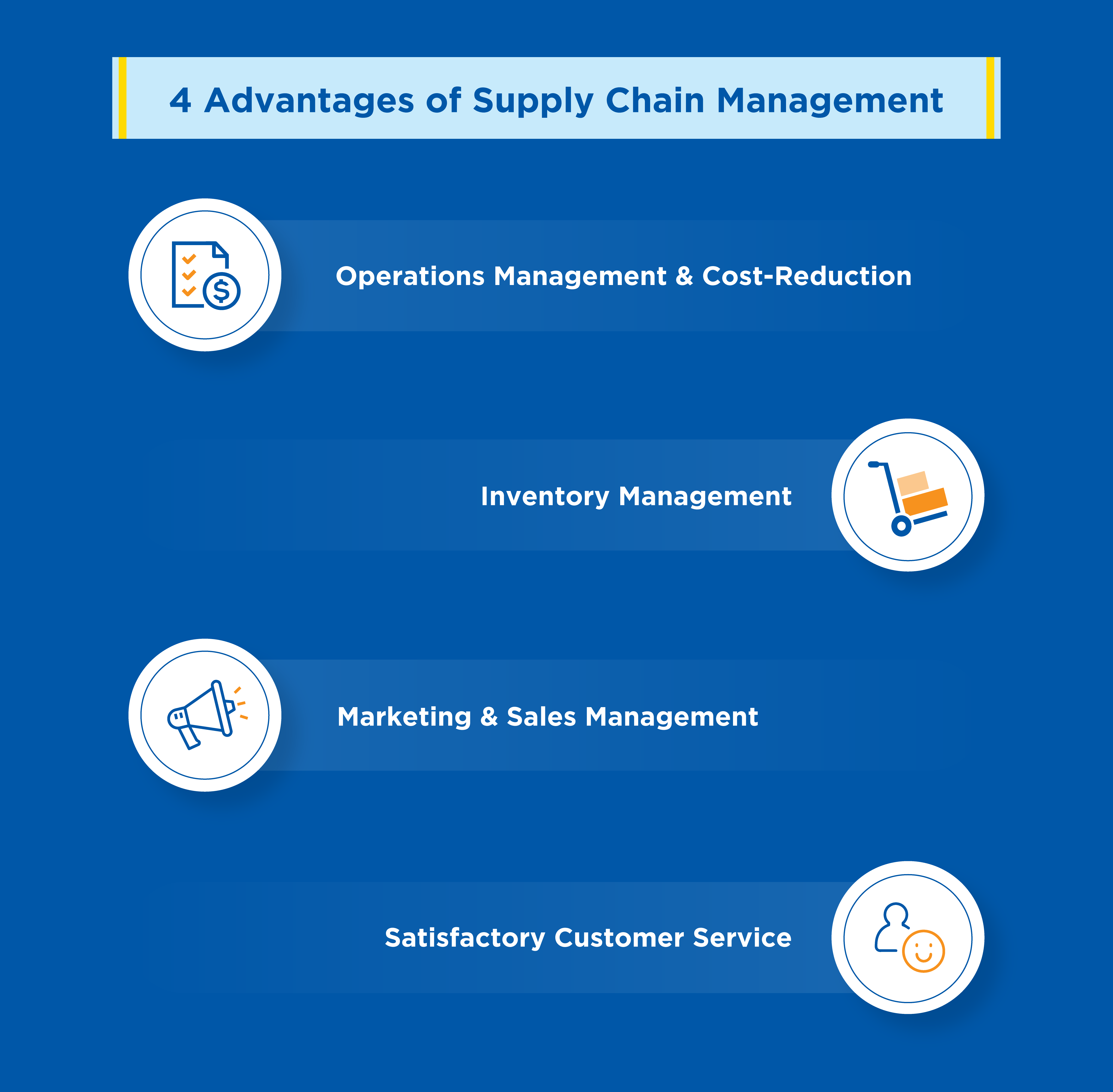
Supply chain management helps you achieve several objectives that are crucial for business operations. Below are a few ways your company can benefit from efficient supply chain management.
Operations Management & Cost-Reduction
Supply chain management can help you execute business operations efficiently and reduce the cost of operations. But you need to plant the seeds of efficiency during supply chain planning. If you plan the SCM processes well, you can significantly reduce the waste of resources. Consequently, you also reduce the cost of operations.
Furthermore, an efficient supply chain strategy can save money at several stages. It can reduce the cost of production, transportation, and storage. Smooth supply chain management ensures that each component of the system works in response to the other.
Inventory Management
Inventory management is a part of SCM. But it has a significant impact on business operations by itself. You need to ensure that you are never out of stock for in-demand products. At the same time, you also do not want to over-stock products.
The success of inventory management depends on efficient supply chain solutions. If you have a dependable supply chain, then you do not have to fear understocking. At the same time, a well-defined supply chain strategy also ensures that you only produce a volume that you can sell. Consequently, it saves you from losses resulting from expired products.
Supply chain management can also help you reduce resource investment in inventory management. If you can manage the required flow of products, you do not have to invest heavily in resources for storage and transportation.
Marketing & Sales Management
Supply chain management can help you plan your marketing and sales strategies. The maximum capacity of a supply chain decides the number of customers you can serve. In turn, this decides the number of customers you need to target through marketing.
Efficient supply chain planning can help you reduce the cost of operations. This not only increases your profit margins but also creates room in your finances for attractive offers. You can entice more customers with discounts and free shipping.
Furthermore, efficient supply chain management is crucial for fast delivery and product returns. Both of these aspects can impact customers’ purchase decisions.
Satisfactory Customer Service
The ultimate goal of SCM is to get the products to the customers. At each stage of the supply chain management process, a company can improve its products and services. At the manufacturing stage, a company ensures product quality. With efficient supply chain logistics, a company ensures that the customer receives their product on time.
Furthermore, the reverse logistics process also allows the customer to return the product if they are not satisfied with it. Consequently, supply chain management has a great influence on customer service.
Supply Chain Management Best Practices
You can improve supply chain management for your company in several different ways. Here are a few SCM best practices to help you reduce costs and increase efficiency.
Purchase in Volume to Reduce Cost
You can significantly reduce the cost of a supply chain by dealing in large volumes. For example, you can source 12 tonnes of supply in a single order instead of 3 tonnes every quarter. According to economies of scale, a large volume helps you reduce cost per unit.
Consequently, you can improve your profit margin from each sale. Aside from bulk purchases, you can also benefit from volume through blanket orders and standing orders. Furthermore, commitment to a larger volume also helps you cut costs in other aspects of supply chain management.
Though you have to spend more resources on individual operations. You can draw a better price per unit at each stage. These savings snowball into a significant profit margin on product sales.
Diversify Source of Supply
Risks concerning suppliers are among the biggest challenges for the supply chain management. These include supplier capacity, financial health, technological adaptability, ethical practices, and so on.
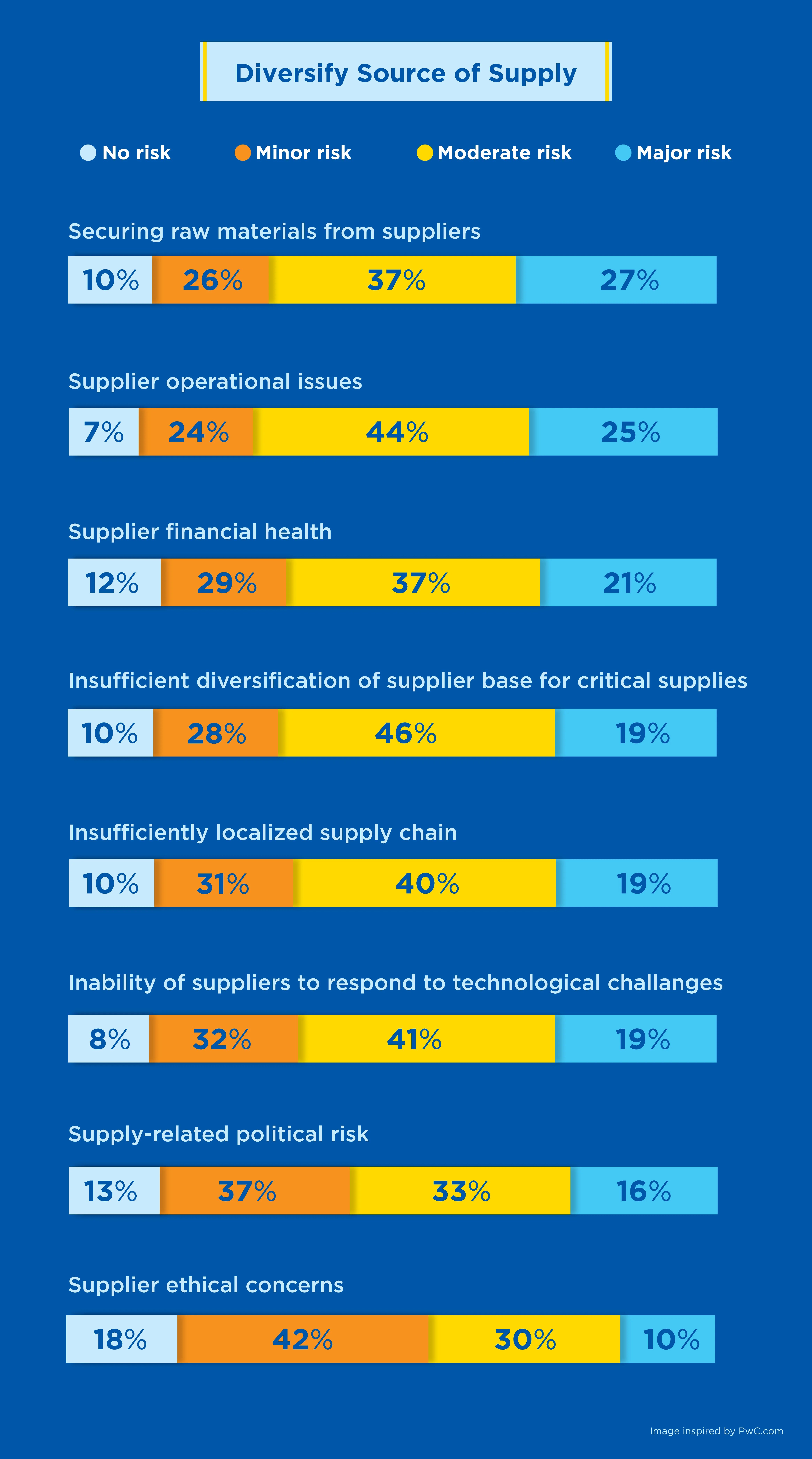
You can protect your supply chain operations from disruptions by diversifying your source of supply. You should have multiple vendors for raw materials, manufacturing, product storage, distribution, logistics, and so on. So even if one of your vendors fails to deliver, you can still protect your supply chain processes.
Digitise & Automate Supply Chain Management
Digitising your supply chain management brings about four important benefits. First, it helps improve communication throughout the supply chain. Second, it streamlines the processes with minimal human intervention. Third, it generates data points to understand the performance of the supply chain operations. And fourth, it creates opportunities for automation.
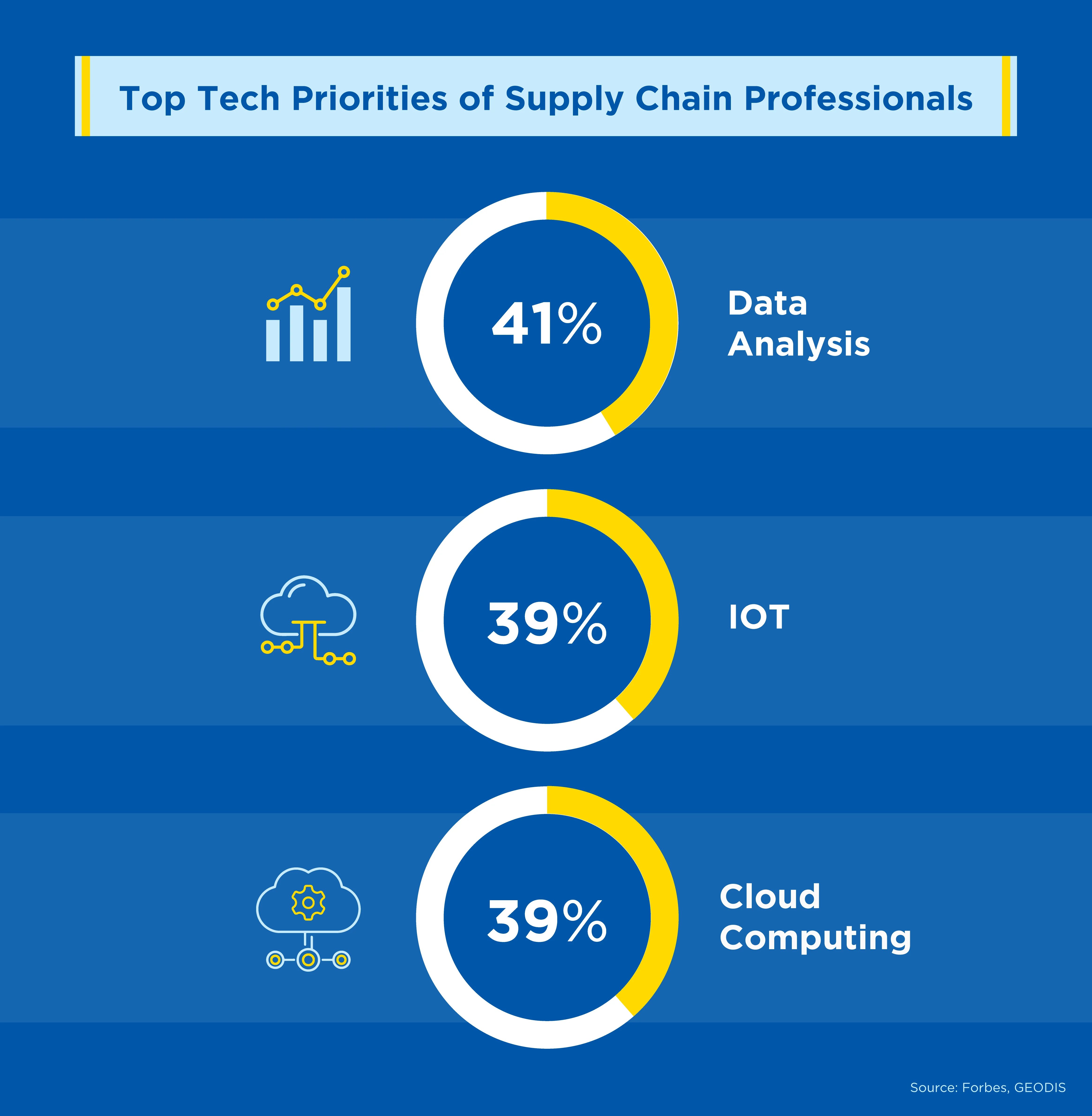
Digitisation can also connect supply chain management with other business operations. It will help you integrate the overall business process towards specific goals. For instance, you can connect supply chain management with marketing. This will allow you to change your supply chain strategy based on market predictions.
Furthermore, you can also automate these processes to react to changing business goals and customer demands. You can also automate SCM processes to react to problems within the supply chain. For instance, if one supplier fails to deliver materials on time. The supply chain software can automatically place an order with another supplier and update the logistics operations accordingly.
Create a Sustainable Supply Chain
According to a survey by Oxford Economics, 85% of supply chain executives said that sustainability initiatives are a major part of their strategies. Additionally, 63% of respondents also agree that sustainability in supply chain strategies reduces costs in the long term.
You need to consider sustainability in all aspects of supply chain operations. Alongside ESG sustainability, you also need to consider the long-term health of your SCM components. During the supply chain planning stage, you should consider the optimum performance capacity instead of the maximum performance capacity. You can employ technology and innovative solutions to balance your business as well as sustainability goals.
Wrapping Up
Supply chain management is unique to each business. You can use supply chain examples from similar industries to design a strategy for your business. But, you also need to fine-tune it to suit your requirements. At the same time, you also need to consider the limitations of your resources.
There are numerous variables to consider when you develop your SCM strategy. The better you can plan your supply chain operations, the more benefits you can reap from their efficiency.
FAQs
What is Supply Chain Management?
Supply Chain Management, also known as SCM, is the planning and execution of a company’s flow of operations. An SCM cycle begins with sourcing raw materials to manufacture products and completes when the customer receives the product. Supply chain management includes procurement, manufacturing, logistics, storage, and transportation.
Why is Supply Chain Management Important?
Supply chain management ensures that a company has the resources to serve its customers. If the supply chain breaks down, a manufacturer does not get raw materials, a company cannot get products, and they cannot supply those products to the customers. SCM balances the demand from customers with the supply of products.
What is Supply Chain Quality Management?
Supply chain quality management is a process or a set of processes that helps measure and monitor the quality of a supply chain. It also applies to processes that measure the quality of products that come through different supply chains.
What is Logistics and Supply Chain Management?
Supply chain logistics refers to the management, storage, and transportation of goods within the supply chain. Logistics is a part of supply chain management. It is involved in the transportation of goods from supplier to manufacturer. Logistics also comes into play for the transportation of finished products from the manufacturer to the customer.
What is Operations and Supply Chain Management?
Operations and supply chain management refers to the planning, supervision, and execution of different operations within a supply chain. It is a broad field that covers processes like procurement, manufacturing, storage, transportation, and more. This field also refers to the management of operations within each of these processes.
Image Sources: Invespcro
